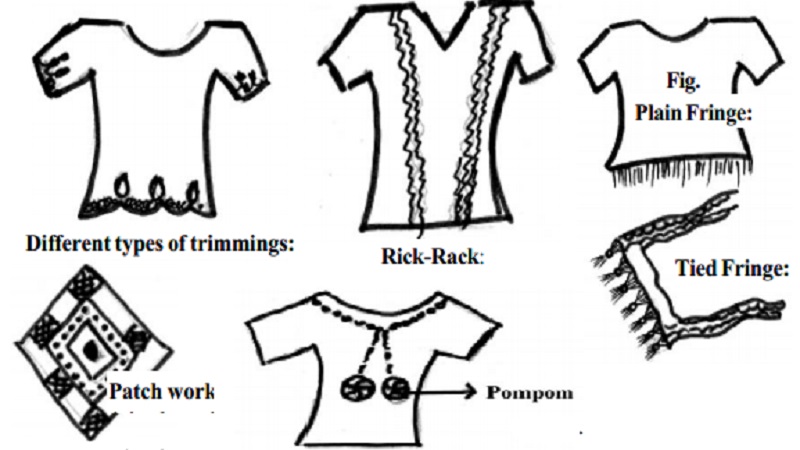Chapter: 11th 12th std standard Textiles And Dress Designing Cloth stitch Higher secondary school College practical steps methods Notes
Garment Enrichment - Trimmings and Different types of Trimmings

Trimming:
Trimmings are edge finishes. They are different types of trimming. It can be classified as:-
Decorative trimming: Decorative trimmings are edge line decoration, which emphasis only on beauty, like lace, or fance button, placed just for beauty. In case this is not handled properly, it appears funny. It has no functional importance.
Constructive trimming: Constructive trimmings are finishes on the construct positive lines, mainly to emphasis the curves, and other body shaping lines.
Both types are added to finished garments, but he difference lies in the placements of the trimmings.
Different types of trimmings:
Embroidered edgings: These can be brough by the yard either gathered or ungathered. In case of plan ones, you can gather it, but buy 1� times more than the trim. This sewed flat on the edge. Mainly in collars, cuffs, or hems without gathers.
Rick-Rack: This is a strip of curved inter woven material, used inserted in pleats or lapped seams. Apart from other edge. It is easy to launder. It is sewed on flat material. In case of edges, it is stitched at center on wrong side.
Fringe: This is made by the wrap or weft yarn on a card board that is cut to the desired width of fringe plus �' seam allowance. Stitch with short stitches at machine, cut open ends of yarn, and pull away cardboard. Insert yarn in fabric seam. This is decorative finish for pockets. There are two types of fringes. They are plain fringe and tied fringe.
Plain Fringe: Fringe of nay width can be made from silk or cotton crochet thread or wool yarn by winding 3 or 4 strands at one time around heavy paper. The thread is wound until the desired amount of fringe is needed and machine stitched near the top. Strands was cut at the bottom and the paper is removed. The prepared fringeis then attached on the garment to be decorated.
Tied Fringe: The needle with a long eye is threaded with double strands and an upward stitch is made ate the edge or a marked line on the fabric. The needle is inserted through the loop and the loop is pulled upwards. This is repeated to a desired number and half of the strands of the 1st is tied to half of the strands of the 2nd. This is repeated forming a tied fringe.
Tassels: Tassels can be made of any size or colour by using embroidery thread or yarn. It could be made of any thickness and length. For making this, a cardboard is cut of any length to which the length of the tassel to be. then the thread or yarn is wound around it to the desired thickness. The top threads are knotted and the bottom threads are cut. The knotted portion is sewn to the fabric using hand needle.
Lace Work: Lace can be attached to the fabric in different ways. for attaching the lace at the edge of the fabric, the fabric edge is turned to the wrong side once and the lace is folded in and kept at the wrong side and given a top stitch.
Lace can be stitched at the edge, centre or seamline. Lace can be gathered at the curved edges. It can be attached to the raw edge by basting the lace close to the edge on the right side of the material, turning the material to the wrong side and rolling the edge of the fabric.
Lace motifs are attached to the fabric by using running stitches.
Ricrac is available in different colours at very low cost and is very durable. It can be sewn flat on garment through centre. It adds the beauty of the dress.
Patch work: This is an art craft of textiles where more than three pieces are joined together by using machine or hand stitches. In this, size, shape and number of pieces may vary. two pieces are kept right sides facing each other and given machine stitch for plain patch work.
For quilt top patch method the sponge is kept below the patch piece and given machine stitch.
For cut and stagger method patch work horizontal strips are joined together and cut and attached according to the required design.
Pompon: This is made of wool, to finish woollen cords. Cut two circular cardboard, for the required size of pompon. Then take the wool from the center to edges, and repeat it tightly to finish the circular. Then cut the outer edge. Tie tightly at center, remove the cardboard. Trim to required size and attach suitably on the garmnet.
Apart from these there are number of other trimmings as scappoped edges, buttons, belts, knots, shul edges, trapunts, quailing, etc.
Related Topics